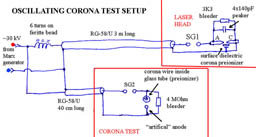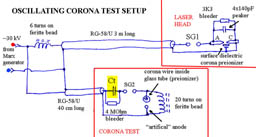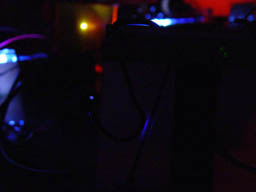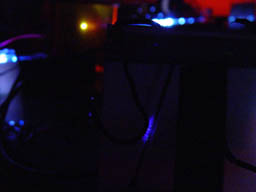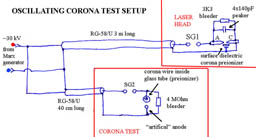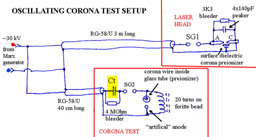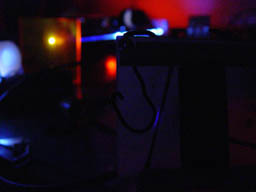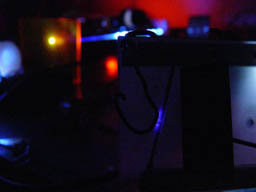Note: at any picture you can click and magnify to 1024 x 768 pix
I was got amazing idea to make one test for future work with preionizer for TEA lasers.
I call it "oscillating corona preionizer", because instead only one corona pulse I want get
more corona pulses before main discharge in laser channel (with significant delay between
corona preionizing UV light and main discharge). This delay I want because I think that
electrons haven't enough time to escape from cathode surface by photoelectric effect
before main discharge in laser channel. In "classic" laser setup, I think this delay is very short.
Because haven't chance to measure this delay with some instruments like oscilloscope, I will
make more experiments until get laser plasma in laser channel without any white sparks and
maybe with more output power.
Before apply this new setup to my new laser head, I was make decision to firstly make few
experiments to confirm my idea, and I was got some "proof", but until this setup implement in
"right" laser head, I only guess is it work as I planned.
Idea is simple: make another spark gap, add one coil to preionizing corona wire and power
it with shorter coaxial cable than cable to laser head to achieve some delay between corona
and main discharge. Aside longer cable to laser head, I was try put little ferrite bead with few
turns after Marx generator and before cable to laser head. Tonight I was make few experiments
with separately laser head (as dummy load) and corona preionizing test setup. Only by looking
at all pictures in next table you can make some conclusions, because was not make any "right"
electrical or optical measurement.
First test with 6 turns on ferrite bead for delaying pulse to laser head
Now, you can see difference in brightness between this two corona lights.
(little blue line in front of setup at pictures)
Because of so fast oscillating (read: high frequency), I can't make measurement with my poor oscilloscope.
But I was make another setup with lower frequency to show you how looks this sustained oscillations:
(still, picture is very bad, but haven't chance make better one, like with digital scope which I haven't)

Second test without ferrite bead from Marx generator to cable.
(I hope that longer cable itself make delayed pulse)
Later was make another experiment, with "Ct" capacitor of 500 pF. Corona is not much
brighter, but laser pulse from TEA laser head is almost totally suppressed. This is because
I was "stolen" about 200 milli Joules, which is 1/3 of whole energy from Marx generator.
Laser still operate, but now with much lower output power. Before finally conclusion, look
at this picture how is badly decreased laser output (little yellow spot behind corona test setup):

Little conclusion: I _think_ that my idea work, but without right proof with applied this setup in
new laser head I can't make enough "strong" decided statement that I'm right. This idea have one
little disadvantage - if pulled energy from Marx generator to corona preionizer is too high, then
laser can't operate with full power. But, I still believe that my current Marx generator have too
low output power, and when I pull too much energy to preionizer then laser fail. I hope soon make
better Marx generator with much more power, and then corona preionizer will need only few
percent of whole output power from this unit.
